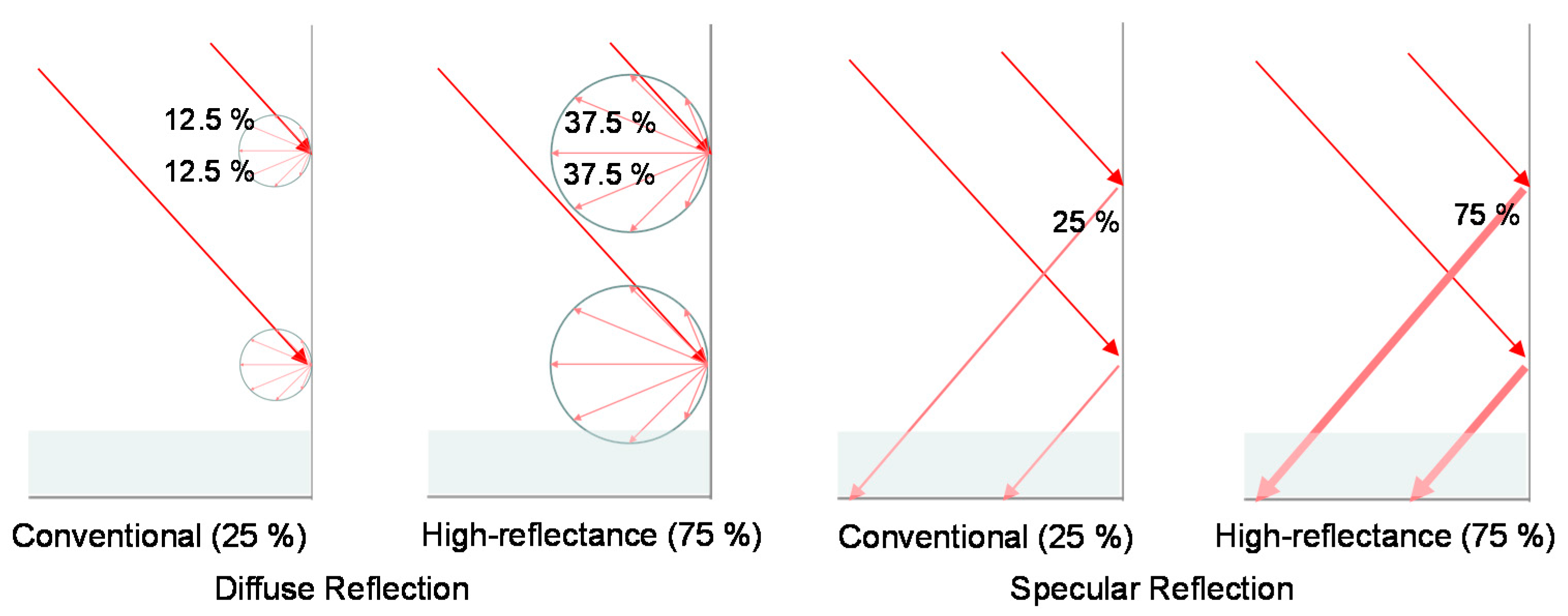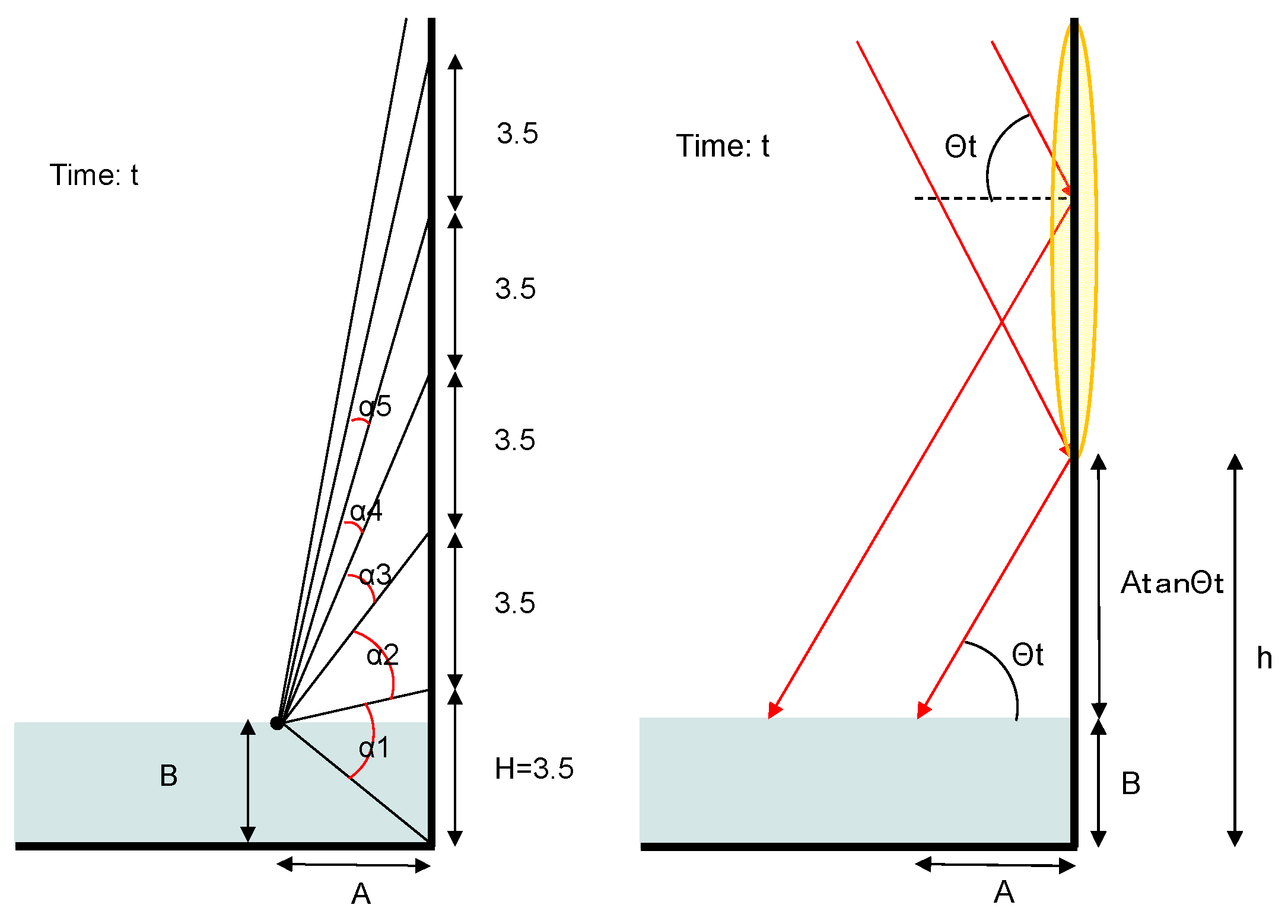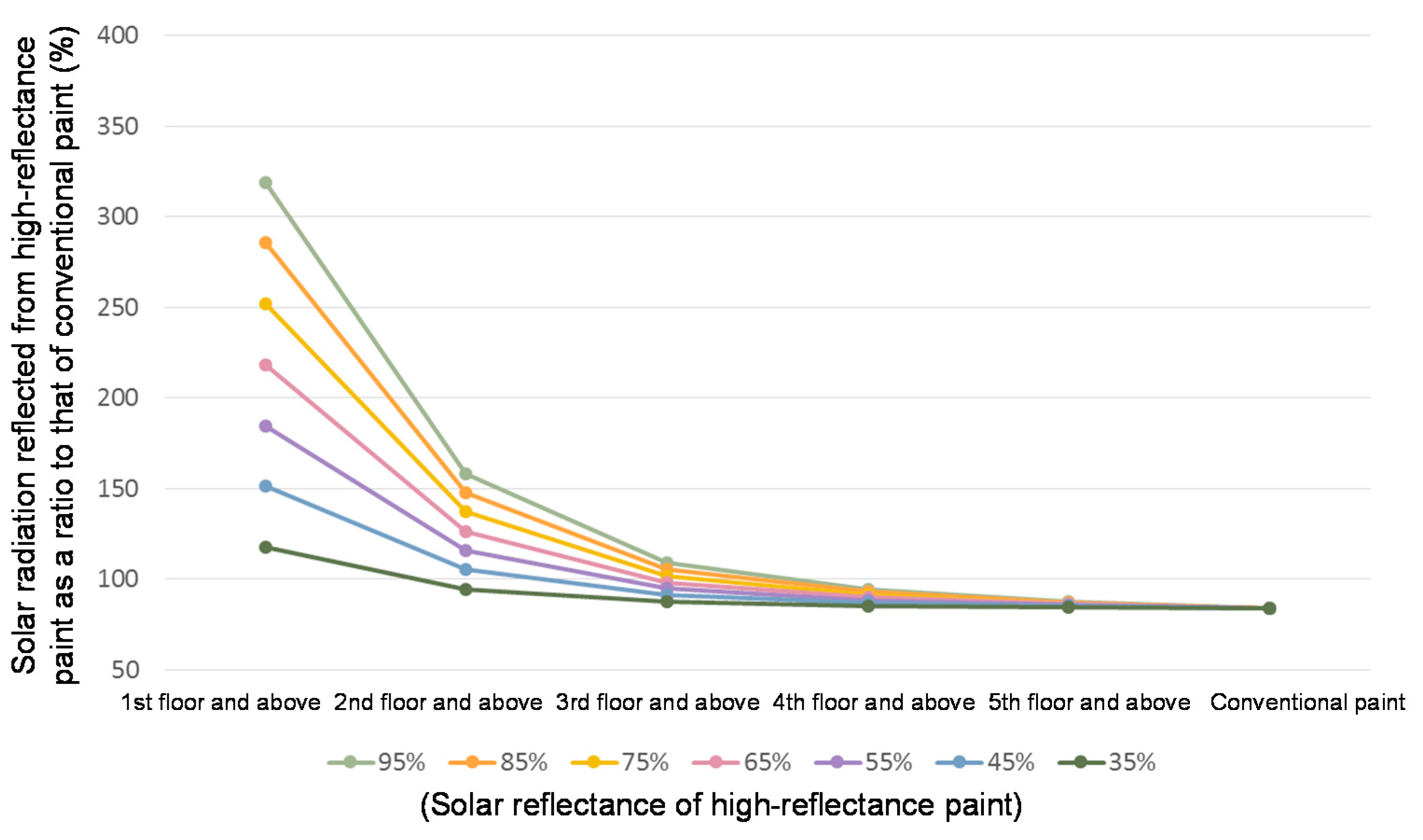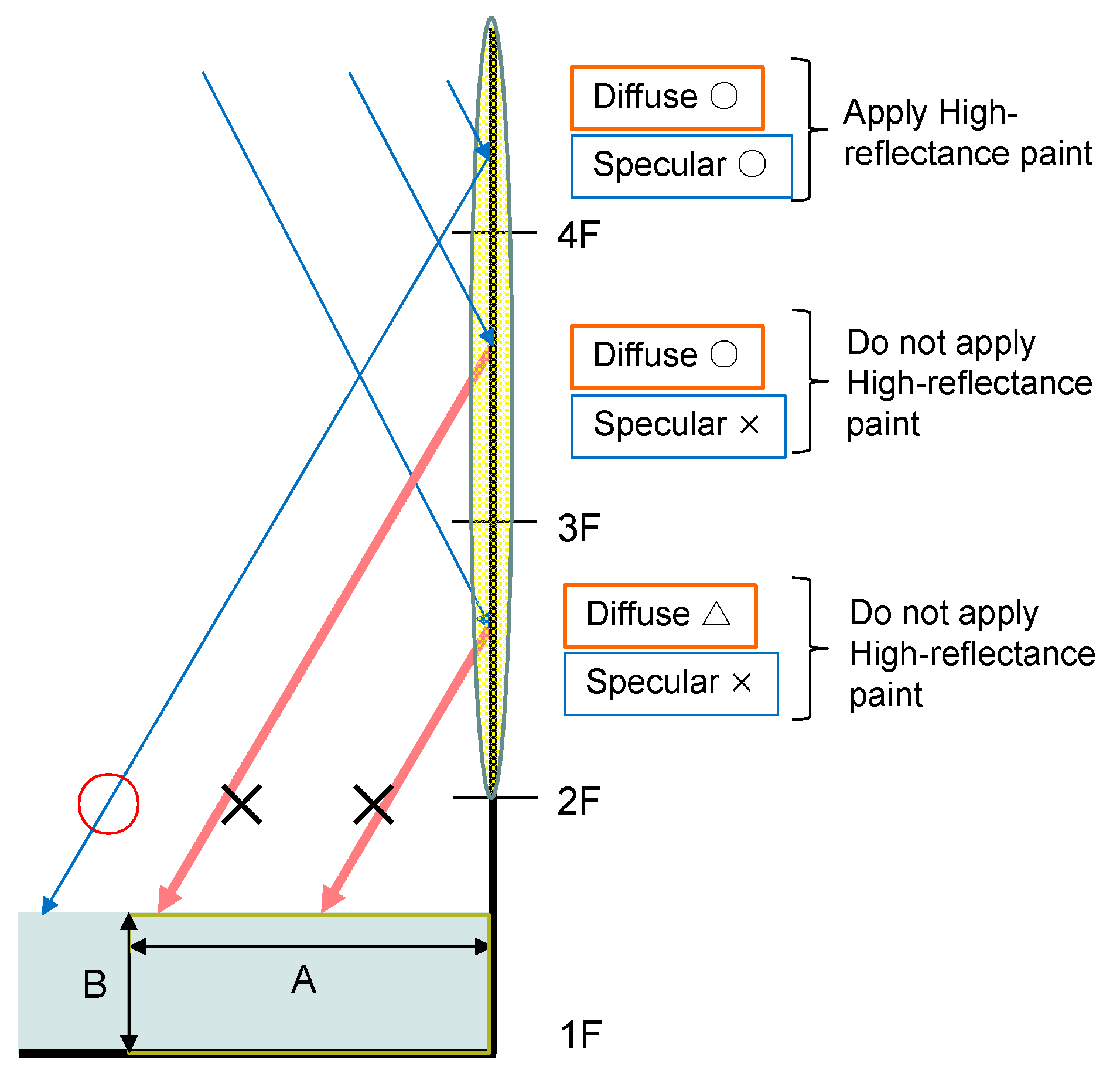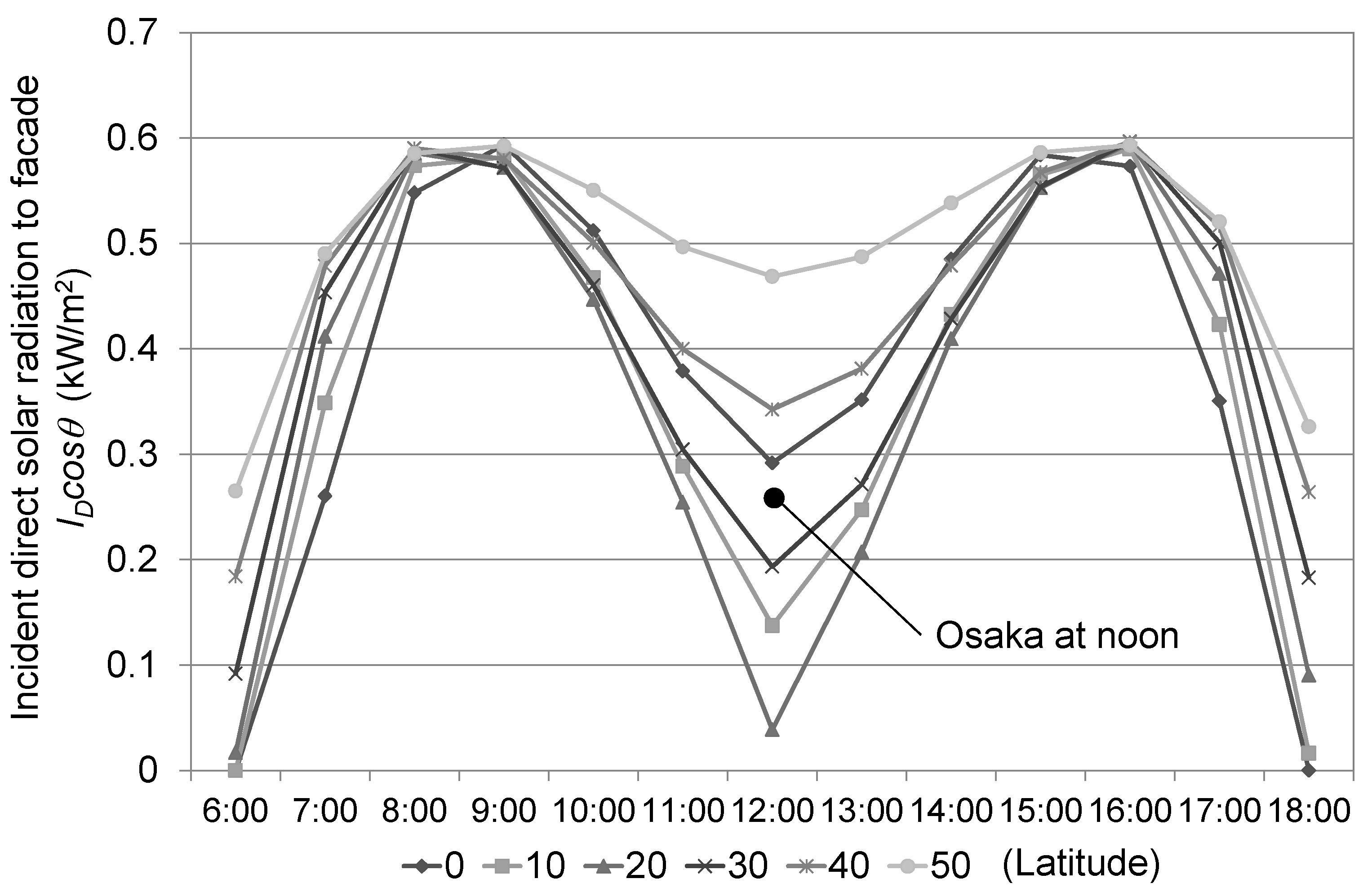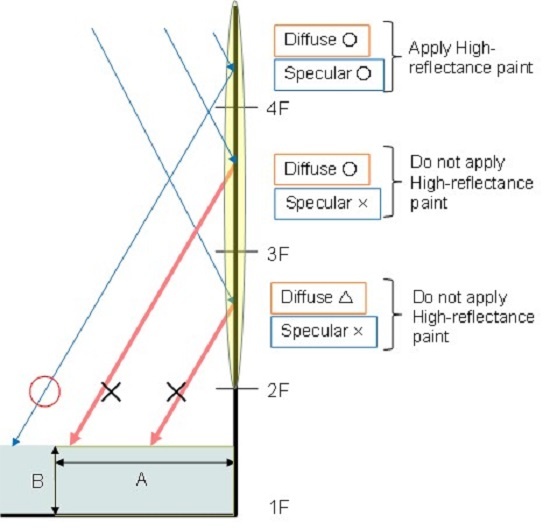1. Introduction
As a measure to counter the urban heat island phenomenon, high-reflectance technology, such as cool roofs and cool pavement, can be applied to places with large incident solar radiation [
1,
2,
3,
4,
5,
6,
7]. Since the solar radiation incident on a building façade is small compared with that on roofs and pavement [
8], the priority for cooling measures on building façades is low. In addition, high-reflectance technology applied to building façades reflects solar radiation downward as well as upward.
To address this problem, retroreflective materials have been studied [
9,
10,
11,
12,
13,
14,
15,
16,
17,
18,
19,
20]. Retroreflective materials have already been used in various applications, such as on street signs [
21,
22]. Yuan et al. [
9] evaluated the durability of retroreflective materials in long-term outdoor exposure, and estimated their retro-reflectance using a spectrophotometer and the heat balance calculated from outdoor temperatures. Yuan et al. [
10] also evaluated the total albedo and the cooling and heating loads for an urban canyon that had retroreflective materials applied. Yuan et al. [
11,
12] evaluated the retro-reflectance of these materials using an emitting-receiving optical fiber system. Rossi et al. [
13] measured the angular reflectance of retroreflective materials experimentally, and then compared their measurements with the ones obtained through an equation that they devised for evaluating angular reflectance based on diffuse reflection. Rossi et al. [
14] made more measurements of the angular reflectance of several types of retroreflective materials and evaluated the energy subsequently entrapped in an urban canyon at various latitudes and days. Rossi et al. [
15] further evaluated the urban heat island mitigation potential of retroreflective pavement in urban canyons through an experiment in an existing small-scale urban canyon. Measurement and calculation methods for determining angular reflection from building materials have been studied by Ichinose et al. [
16], Nakaohkubo et al. [
17], Nishioka et al. [
18,
19], and Yoshida et al. [
20].
In the current study, the appropriate introduction of highly-reflective technology on building façades is evaluated. Effects on the indoor environment have been previously evaluated, e.g., by Pisello et al. [
23], and are not considered here. Several thermal comfort indices for evaluating a pedestrian thermal comfort have been proposed such as PMV (predicted mean vote), SET* (standard new effective temperature), ET* (new effective temperature), PT (perceived temperature), PET (physiologically equivalent temperature), UTCI (universal thermal climate index), and WBGT (wet bulb globe temperature) [
24,
25]. Generally, six thermal parameters (air temperature, humidity, air velocity, mean radiant temperature, col-value, and metabolic rate) are required to calculate index values. In this study, the focus is on the impact of solar radiation reflected from the building façade to a pedestrian. The objective of this paper is to assess the impact of the high-reflectance technology introduced on building facades, by comparing with the current condition. The effect on the pedestrian through the longwave radiation heat exchange on a building façade with a low surface temperature that high-reflectance technology is introduced, which is calculated in the same way as the diffuse reflection calculation, is not so large as compared with the effect by the reflected solar radiation from building façade, since the surface temperature reduction effect by introducing high-reflectance technology is distributed into convection, radiation, and conduction heat flux reductions. Therefore, I have focused only on the change of the reflected solar radiation from the current condition.
2. Solar Radiation Reflected from Building Façades
Figure 1 shows reflection from a building façade. A simple, two-dimensional building façade was used for all computations. The incident angle of the direct solar radiation is specified by the sun angle (a function of date, time, and latitude), regardless of the orientation of the objective façade. The diffuse reflection of solar radiation is taken as half upward and half downward from the horizontal. Reflectance values of 0.25 for conventional materials and 0.75 for high-reflectance materials were used in all computations.
Since the diffuse reflection does not depend on the sun angle, the change of the sun angle may not be taken into account. Additionally, since the most significant impact on pedestrians near the wall by the specular reflection occurs in the high sun angle condition, the influence by the specular reflection should be considered in the high sun angle condition.
In the case of a completely diffuse surface, such as concrete, paint, or wood, used as a conventional building façade, 12.5% of the solar radiation is reflected upward and 12.5% is reflected to a pedestrian area. Approximately 75% of solar radiation is absorbed by the building façade, and is redistributed as sensible or radiative heat flux into the street canyon and to the building interior, which increases the indoor cooling load. In total, 87.5% of solar radiation is converted into heat near the ground surface.
In the case of a high-reflectance, but completely-diffuse building façade, 37.5% of solar radiation is reflected upward and 37.5% is reflected to a pedestrian area. Approximately 25% of the solar radiation is absorbed by the building façade, and is redistributed as sensible or radiative heat flux into the street canyon and to the building interior. In total, 62.5% of solar radiation is converted into heat near the ground surface. Therefore, heat generation near the ground surface is reduced 25% when the solar reflectance of a completely-diffuse building façade changes from 0.25 to 0.75.
In the case of a completely-specular surface, such as metal, glass, or tile, used as a conventional building façade, 0% of solar radiation is reflected upward and 25% is reflected to a pedestrian area. 75% of solar radiation is absorbed by the building façade, and is redistributed as sensible or radiative heat flux into the street canyon and to the building interior. In total, 100% of solar radiation is converted into heat near the ground surface.
In the case of a completely-specular high-reflectance building façade, 0% of solar radiation is reflected upward and 75% of solar radiation is reflected to a pedestrian area. The rest, i.e., 25% of solar radiation is absorbed by the building façade, and is redistributed as sensible or radiative heat flux into the street canyon and to the building interior. In total, 100% of solar radiation is converted into heat near the ground surface. Since specular materials introduce such large amounts of heat near the ground surface, cool façades are recommended to reduce heat island effects.
The solar radiation reflected to a pedestrian area is increased 25% in the diffuse surface case and 50% in the specular surface case when the solar reflectance of the building façade changes from 0.25 to 0.75. The impact of solar radiation reflected from the building façade to a pedestrian must, therefore, be further evaluated.
3. Effects on Pedestrians
3.1. Diffuse Surfaces
The effect of diffuse reflection of solar radiation from the building façade to a pedestrian depends on the distance from the objective building façade surface to the pedestrian. Pedestrians are modeled as points for computational purposes. The ratio of diffusely-reflected solar radiation to a pedestrian from a given floor is proportional to the ratio of the angle of the reflective arc reaching a pedestrian from that floor to the angle of the reflective arc from the entire building (
Figure 2) [
26]. A Monte Carlo calculation method to track a sufficient number of particles between the divided small components of the façade, road, and other surfaces are used for diffuse reflection of solar radiation from the building façade in previous studies [
8,
10,
12,
18]. In this study, since assuming a simple two-dimensional model without trees or eaves, a fairly simple method is adopted. The angle from the objective building façade of each floor to a pedestrian is calculated as:
where
αi is the angle from the objective building façade on each floor (rad),
i is floor number,
A is the distance from a pedestrian to the objective building façade (m),
H is the height of each floor (m), and
B is the height of a pedestrian (m).
The effect on pedestrians from diffuse reflection of solar radiation from the building façade on floor i can be evaluated by multiplying the solar reflectance value of the building façade on floor i by the angle αi. The effect on pedestrians from high-reflectance technology with a solar reflectance of 0.35, 0.45, 0.55, 0.65, 0.75, or 0.85 that is applied to the first (ground), second, third, fourth, or fifth floor and above, respectively, is calculated as a ratio to that of a conventional building façade. A floor height (H) of 3.5 m is used in all cases.
The ratio of the diffuse reflection of solar radiation from the building façade to pedestrians (
A = 2 m,
B = 1.5 m) is shown in
Figure 3. The floors at and above which high-reflectance technology is applied are indicated on the horizontal axis. The reflection of solar radiation from a conventional building façade is taken as 0.25. The effect on pedestrians by high-reflectance technology is larger when it is applied to lower floors, when its solar reflectance is larger, and when the distance between the building and pedestrians is smaller. When high-reflectance technology is applied above the third floor, the effect on pedestrians is less than 120% of that from a conventional building façade. The introduction of high-reflectance technology above the third floor is, therefore, acceptable from the viewpoint of adverse effects on pedestrians.
3.2. Specular Surfaces
The effect on a pedestrian by specular reflection of solar radiation from the building façade depends on the incident angle of direct solar radiation and the distance from the objective building façade to a pedestrian (
Figure 2). The height at which the specular reflection of solar radiation from the building façade does not affect pedestrians is calculated as:
where
h is the height at which specular reflection of solar radiation from the building façade does not affect pedestrians (m),
A is the distance from the objective building façade to a pedestrian (m),
θ is solar angle (°), and
B is the height of a pedestrian (m). Specular reflection of solar radiation from the building façade is calculated by a ray-tracing method corresponding to the solar angle
θ, as well as Nishioka et al. [
18] and Yuan et al. [
10,
12].
The height at which the specular reflection of solar radiation from the building façade does not affect a pedestrian (
A = 2 m,
B = 1.5 m) at 12:00 on August 1st in Osaka (34°40′ N;
θ = 73.6°) was calculated as 8.3 m from the ground, or above the fourth floor if
H = 3.5 m. Since specular reflection is likely to occur at high sun angles, it is recommended that high-reflectance technology be used on building façades above the fourth floor in this particular case (
A = 2 m,
B = 1.5 m, in Osaka) (
Figure 4).
While Yuan et al. [
10] have studied the total albedo of the urban canyon which is dependent on the urban canyon shape and the angle of incident solar radiation, the focus is on the impact of solar radiation reflected from the building façade to a pedestrian in this study. However, the influence by the opposite side building should be considered. Since the distance from the opposite side building is large, the influence by the diffuse reflection is sufficiently small. Though the influence by the specular reflection cannot be ignored, if the influence by the specular reflection from the near side building is avoided, pedestrians can walk on this side.
The height at which the specular reflection of solar radiation from the building façade does not affect a pedestrian (
A = 2 m,
B = 1.5 m) on August 1st was calculated for every hour and every latitude (
Figure 5). High-reflectance technology is applicable on building façades above the fourth floor at any latitude, if we ignore a negative effect, since incident direct solar radiation to the building façade around noon is small at low latitudes (
Figure 6).
4. Effects of Using Retroreflective Materials
Adverse effects on a pedestrian from the reflection of solar radiation are an issue when high-reflectance technology is applied to building façades. Retroreflective materials have been studied as a way to address this problem [
9,
10,
11,
12,
13,
14,
15,
16,
17,
18,
19,
20]. The shape and reflection characteristics of retroreflective tile and the effects of using retroreflective material on the lower floors are shown in
Figure 7. A retroreflective tile [
27] that is already commercially available in Japan was used in this study. Only a very small fraction of solar radiation is reflected downward from the retroreflective material (
Figure 7).
4.1. Ideal Retroreflective Materials
Based on the study results in the previous chapter, we model using retroreflective materials on the lower levels (third floor and below) (
Figure 7). Pedestrians are not affected by retroreflective material that is applied to the building façade below the third floor so long as the solar radiation is reflected completely upward. Only the diffuse reflection from high-reflectance technology applied to the building façade above the fourth floor would affect pedestrians. The amount of solar radiation reflected to a pedestrian from an ideal retroreflective material is calculated as a ratio to that of a conventional building façade with solar reflectance of 0.25 (
Figure 8). A solar reflectance of 0.75 is used for both high-reflectance materials and retroreflective materials. Results were calculated for two cases. In the first case, high-reflectance technology was applied to the fourth floor and above, while a conventional façade was used on the third floor and below. The calculated value for this case was 104. In the second case, high-reflectance technology was applied to the fourth floor and above while retroreflective material was applied to the third floor and below. The calculated value for this case was 6.
4.2. Actual Retroreflective Materials
The retroreflective tile used for this study consists of an upward slope of 45 degrees to horizontal and a downward slope of 30 degrees to horizontal (
Figure 5). Since a part of solar radiation is reflected diffusely from each slope surface, it is not a completely retroreflective material. Even so, a relatively large amount of solar radiation is reflected upward. According to measurements provided by Harima et al., when incident solar radiation is 60° to the objective building façade, almost two-thirds of solar radiation is reflected upward, and another one-third is reflected downward. Therefore, 50% of solar radiation is reflected upward and 25% of solar radiation is reflected downward from an overall solar reflectance of 0.75 for retroreflective tile. For comparison, when the overall solar reflection of high-reflectance paint is 0.75, 37.5% of solar radiation is reflected both upward and downward. When the overall solar reflectance of a conventional façade is 0.25, 12.5% of solar radiation is reflected both upward and downward. Therefore, the effect on pedestrians from using retroreflective materials is similar to the effect from using high-reflectance paint.
5. Conclusions
The possibility of using high-reflectance technology on building façades was evaluated by using a two-dimensional simple building façade model. The effectiveness of applying retroreflective materials to building façades was also evaluated in regards to avoiding adverse effects on pedestrians.
In Japanese cities that are located at mid-latitudes, applying high-reflectance technology to a building façade at the fourth floor and above produces reflection of solar radiation that does not have adverse effects on pedestrians. Urban heat island mitigation effects can also be expected. Retroreflective material was considered for use on building façades below the third floor in order to avoid impacts on pedestrians from the reflection of solar radiation. However, solar radiation reflected from a realistic retroreflective material still affects pedestrians. It is necessary to further quantify the impacts of solar radiation reflected from such materials on pedestrians. Retroreflective material is most effective for building façades composed mostly of materials that have specular reflection, such as glass, tile, and metal, for both urban heat island mitigation and the improvement of the pedestrian thermal environment.
